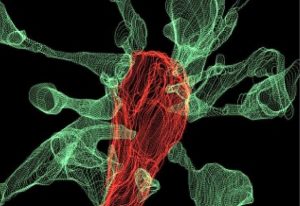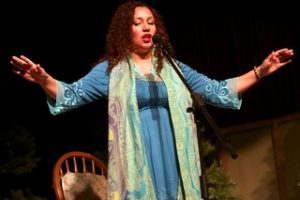Apr 9, 2018
Microglia in the brain nibble on synapse to induce remodeling of neural circuits. Kevin mentions his new online seminar on five ways to enhance long-term learning. A&P is the story of the human body, so A&P professors act as storytellers. Kevin gives some practical tips on how to do that effectively.
Microglia prune synapses to remodel brain
circuits. (6 min)
Kevin's new online seminar on Long-Term Learning.
(1 min)
Teaching A&P tells the story of the human
body. (15 min)
If you cannot see or activate the audio player click here.
Follow The A&P Professor on Twitter, Facebook, Blogger, Nuzzel, Tumblr, or Instagram!

Multiple synapse heads send out filopodia
(green)
converging on one microglial cell (red),
as seen by focused ion beam scanning
electron microscopy (FIBSEM).
IMAGE: L. Weinhard, EMBL Rome
(0:47) New information shows that microglia nibble on presynaptic neurons using trogocytosis, rather than phagocytosis, to prune synapses during memory formation to help remodel brain networks. Microglia also induce postsynaptic spines to "reach out" to form new synapses with presynaptic neurons.
- Microglia remodel synapses by presynaptic trogocytosis and spine head filopodia induction (original research report)
- Captured: microglia nibbling on brain synapses (article about the original report)
- Neurophobia: The Fear of Neurology Among Medical Students (the title says it all)
(6:50) Kevin has a new online seminar on five strategies to enhance long-term learning in A&P courses.
- Long Term Learning (the new seminar)
- HAPS Conferences (see you there?)

Storytellers dramatize their stories.
(my-ap.us/2uvWkPe)
(8:05) Kevin explains why he thinks storytelling is the heart of effective teaching, especially in the A&P course. He outlines the "storytelling persona"; making sure there is a beginning, middle, and end to our stories, applying storytelling to both lectures and the entire course, using drama, conflict and resolution, and other techniques.
- Educational Uses of Digital Storytelling (website with many resources)
- Crash Course in Storytelling (book on the basics of storytelling)
- Long Story Short: The Only Storytelling Guide You'll Ever Need (book; the title says it all)
If the hyperlinks here are not active, go to TAPPradio.org to find the episode page.
- More details at the episode page.
- Transcript available at the script page.
- Listen to any episode on your Alexa device.
- Join The A&P Professor social network:
- Blog
- Twitter @theAPprofessor
- Facebook theAPprofessor
- Instagram theAPprofessor
- YouTube




